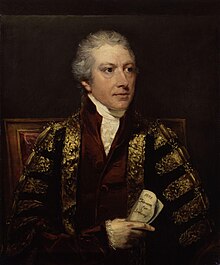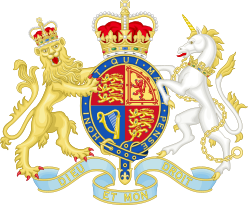Charles Abbot, 1. Baron Colchester

Charles Abbot, 1. Baron Colchester (* 14. Oktober 1757 in Abingdon; † 8. Mai 1829) war ein britischer Politiker und Sprecher des Unterhauses (House of Commons).
Familie und berufliche Laufbahn
Der Sohn eines Schulrektors war durch die erste Ehe seiner Mutter Halbbruder des Philosophen und Begründers des Utilitarismus, Jeremy Bentham.
Nach dem Besuch der Westminster School absolvierte er ein Studium der Rechtswissenschaften am College von Christ Church (Oxford). Dort gewann er nicht nur eine Auszeichnung des Kanzlers für das Verfassen lateinischer Verse, sondern als bester Absolvent seines Jahrgangs als Bachelor of Civil Law (B.C.L.) ein Stipendium. 1783 wurde er zum Rechtsanwalt (Barrister) zugelassen. Bereits am 14. Februar 1793 wurde er wegen seiner wissenschaftlichen Leistungen Fellow der Royal Society (FRS). 1795 wurde er für einige Monate Regularienbeamter am damaligen Obersten Gericht (King’s Bench).
Politische Laufbahn
Abgeordneter
Bereits im Juni 1795 begann er seine politische Laufbahn mit der Wahl zum Abgeordneten des Unterhauses (House of Commons). Dort vertrat er zunächst dank des Einflusses von Francis Osborne, 5. Duke of Leeds, bis 1802 den Wahlkreis von Helston. Bereits nach einem Jahr machte er sich als Mitglied zweier Komitees einen Namen als Reformer. 1802 war er für kurze Zeit Abgeordneter des Wahlkreises Heytesbury, ehe er im gleichen Jahr Abgeordneter des Wahlkreises Woodstock wurde. Bereits nach vier Jahren wurde er jedoch Abgeordneter des Wahlkreises Oxford University, der er nunmehr bis 1817 im House of Commons vertrat.
Parlamentssprecher und Mitglied des Oberhauses
Im März 1801 wurde er im Kabinett von Premierminister Henry Addington zum Chief Secretary for Ireland berufen und hatte damit die Schlüsselposition der britischen Verwaltung für Irland im erst am 1. Januar 1801 neu geschaffenen United Kingdom of Great Britain and Ireland inne.
Bereits im Februar 1802 wurde er als Nachfolger von Sir John Mitford jedoch zum Sprecher (Speaker) des House of Commons gewählt. Dieses Amt übte er zur allgemeinen Zufriedenheit bis 1817 aus, als ihn eine schwere Hauterkrankung (Erysipel) zum Rücktritt von diesem Amt zwang.
Nach seinem Rücktritt wurde er in erblichen Adelsstand erhoben. Er führte den Titel Baron Colchester und gehörte als solcher dem Oberhaus an.
Sein Sohn Charles Abbot, der ihm 1829 als 2. Baron Colchester folgte, war später Generalzahlmeister und Generalpostmeister.
Veröffentlichungen
Literatur
- Britons Fooled. In: Time-Magazine, 9. Juli 1928
- Colchester, Charles Abbot, 1st Baron. In: Encyclopædia Britannica. 11. Auflage. Band 6: Châtelet – Constantine. London 1910, S. 660 (englisch, Volltext [Wikisource]).
Weblinks
- Eintrag zu Abbot; Charles (1757 - 1829); 1st Baron Colchester im Archiv der Royal Society, London
| Vorgänger | Amt | Nachfolger |
|---|---|---|
| Titel neu geschaffen | Baron Colchester 1817–1829 | Charles Abbot |
| Personendaten | |
|---|---|
| NAME | Abbot, Charles, 1. Baron Colchester |
| ALTERNATIVNAMEN | Colchester, Charles Abbot 1. Baron |
| KURZBESCHREIBUNG | britischer Politiker und Sprecher des Unterhauses |
| GEBURTSDATUM | 14. Oktober 1757 |
| GEBURTSORT | Abingdon (Oxfordshire) |
| STERBEDATUM | 8. Mai 1829 |
Auf dieser Seite verwendete Medien
Autor/Urheber: Sodacan, Lizenz: CC BY-SA 3.0
Royal Coat of Arms of the United Kingdom of Great Britain and Northern Ireland in the style used by the Government of Queen Elizabeth II from 1952 to 2022 (as used in all places except Scotland).
| “ | Quarterly, First and Fourth Gules three lions passant guardant in pale Or armed and langued Azure (for England), Second quarter Or a lion rampant within a double tressure flory counter-flory Gules (for Scotland), Third quarter Azure a harp Or stringed Argent (for Ireland), the whole surrounded by the Garter; for a Crest, the imperial crown Proper; for Supporters, dexter a lion rampant guardant Or crowned as the Crest, sinister a unicorn Argent armed, crined and unguled Proper, gorged with a coronet Or composed of crosses patée and fleurs de lys a chain affixed thereto passing between the forelegs and reflexed over the back also Or; Motto 'Dieu et mon Droit’ ('God and my Right') below the shield. | ” |
- PINCHES, J.H & R.V., The Royal Heraldry of England, 1974, Heraldry Today.

